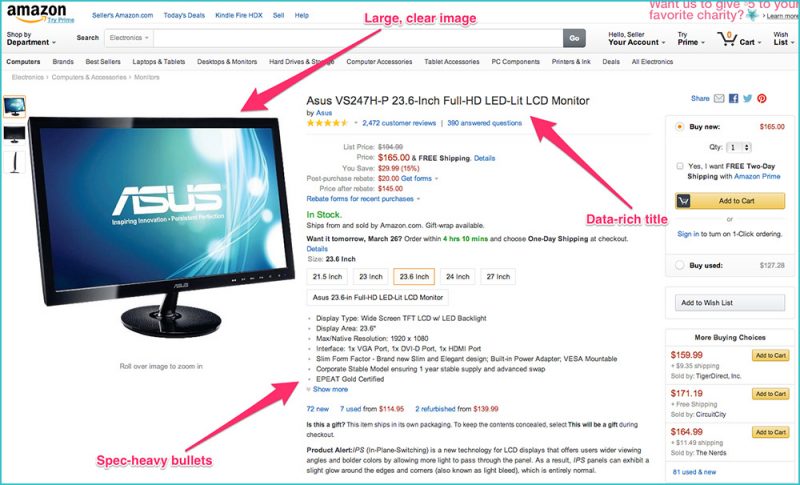E-commerce is a volatile buyers’ market where sellers need to be on their toes. If you are not flexible enough to change your marketing strategy, it will be tough to navigate the waters.
Which Selling Plan Should You Choose?
With the Individual plan, you’ll pay $0.99 every time you sell an item. The Professional plan costs $39.99 per month, no matter how many items you sell. For both programs, Amazon also collects a referral fee on each sale, which is a percentage of the total transaction and varies by product category. Depending on your product & brand exposure and current sales velocity, you should choose the selling plans. If you’re unsure how many products you’ll sell on Amazon, it’s best to start with an individual plan and upgrade it to a professional plan later. You can always switch from an individual to a professional plan and vice versa.
Should You Become a First-Party Vendor or a Third-Party Vendor?
Both of these programs come with their own pros and cons. The most significant difference is that you can control the product price as a third-party (3P) seller, but not as a first-party (1P) seller.
To be able to sell in a 1P capacity, you need to be a manufacturer or brand. Amazon then sends you a purchase order (PO), you fulfill the PO and ship the product back to Amazon. Ownership of the products then transitions to Amazon. The company controls how the products will be priced in the marketplace.
If you choose Amazon’s 3P model, you maintain control of your products and your pricing. You decide if you are going to fulfill your products through Fulfillment by Amazon (FBA), Fulfillment by Merchant (FBM), or Seller Fulfilled Prime (SFP). But let’s not get lost in Amazon jargon. Here’s a quick synopsis of what these terms mean:
- Fulfillment by Amazon (FBA) is a service in which third-party vendors store their products in Amazon’s fulfillment centers, allowing Amazon to pick, sort, pack, ship, track and handle returns and refunds for these products.
- Fulfilled by Merchant, is commonly known as FBM. This is when sellers list their products on Amazon and choose to ship products to each buyer themselves. In other words, sellers are responsible for fulfilling their orders and do not rely on Amazon to do so. While it is a rather advantageous method for products with lower margins, FBM Amazon is less popular than FBA, owing to benefits such as easy shipping, handling, and other features of FBA.
- Seller Fulfilled Prime (SFP) is a program that allows qualified Amazon sellers with Professional Selling accounts to display the Amazon Prime badge on orders fulfilled via their own warehouse(s) or third-party logistics providers.
How Do You Select a Product Category?
Once you have decided on an Amazon selling plan and seller type, it’s time to get your product category right. Having your products affiliated with the correct category ensures that consumers can find you effectively. Start by reviewing the information in Seller Central’s knowledge base to understand Amazon’s definitions of categories. Then search for and review the categories listed for competitive products. Third-party tools such as Sellics & Sellerapp can also help, but these are most useful for advanced sellers.
Some product categories are open to all sellers, some require a Professional seller account, some require approval to sell, and some are not available to third-party sellers at all. Categories with restrictions include Alcohol, Animal-related products, Cosmetics & Skin/hair care, Baby Products, Beauty Topical, Certified Refurbished, Dietary Supplement, Drugs, Electronics, Fine Arts., Medication, Pesticides, Pet Food. Visit Seller Central help to learn more about restrictions and how to request approval. And by reviewing competitive products, you may identify an easier option: listing your product in a category that’s not restricted.
While doing your competitive research, you can also start thinking about how individual products are described. Review the product title, product features, description, images, product Q&A, and key phrases used to describe the highest-ranking products for your search. Dive deeper into competitor positioning by looking at the tone and language used, product packaging, design, and labeling. Also, analyze their enhanced brand content or A+ content. With A+ content, you’re able to add detailed product descriptions, larger images, comparison charts, videos, etc. which help you better convey the value of your products to customers. Continue your research by checking your competitors’ product reviews to understand their strengths and weaknesses. This will help you understand what consumers care most about, which you can address directly in your product info.
How Do You Create a Product Listing on Amazon?
Armed with this research, you are ready to create a product listing in Seller Central. A typical Amazon product listing includes:
- A product identifier such as GTIN, UPC, ISBN, or EAN, to specify the exact item you’re selling. You can get a UPC directly from GS1, or request an exemption.
- A SKU, which is a product ID you create to track your own inventory.
- Offer details, including price, product condition, available quantity, and shipping options.
- Product details like name, brand, category, description, and images.
- Keywords and search terms to help buyers find your product.
Another critical step is to create your product detail page. It should have the right mix of customer-friendly content, including keywords that people are likely to use when they search. Getting this right is as important as your decision to start selling with Amazon. Getting product description, A+ content, and the right amount of keywords with buying intent is another massive topic with lots of ins and out.
A basic product detail page contains:
- Title – 200 characters max, capitalize the first letter of every word
- Images – 500 x 500 or 1,000 x 1,000 pixels to increase listing quality
- Variations – Such as different colors, scents, or sizes
- Bullet points – Short, descriptive sentences highlighting key features and benefits
- Featured offer (“Buy Box”) – The featured offer on a detail page. Customers can add to their cart or “Buy Now”
- Description – Keywords improve the chances that people will find your listing.
How you describe your products is a significant factor in how your product will be ranked on Amazon. The A9 Algorithm is the system that Amazon uses to decide how products are listed in search results. This is somewhat similar to how Google ranks search results on Google.com. However, there is one key difference between Google and Amazon’s algorithms: the A9 Algorithm also puts a strong emphasis on sales conversions. In Amazon, A9 incorporates signals from product reviews, product optimization, keywords, product profitability & margin, buyer intent, % of product return, advertisement, and fulfillment method, to name a few.
This is my first attempt at sharing my knowledge through a blog post. I will be covering more advanced topics such as organic ranking in Amazon, product marketing strategy, avoiding some common errors, tips on product ungating & getting the most out of Amazon to help you boost your market share and revenue. Please subscribe, share, or leave comments & feedback if you enjoyed reading this blog.
These tips should help you get your products set up properly for success. I want to end this post with a point at the end of the day, Amazon cares most about sales velocity. Getting your products selling at strong velocity is your next step. If you have any specific questions about selling on Amazon or need assistance with your Amazon store, contact us.






